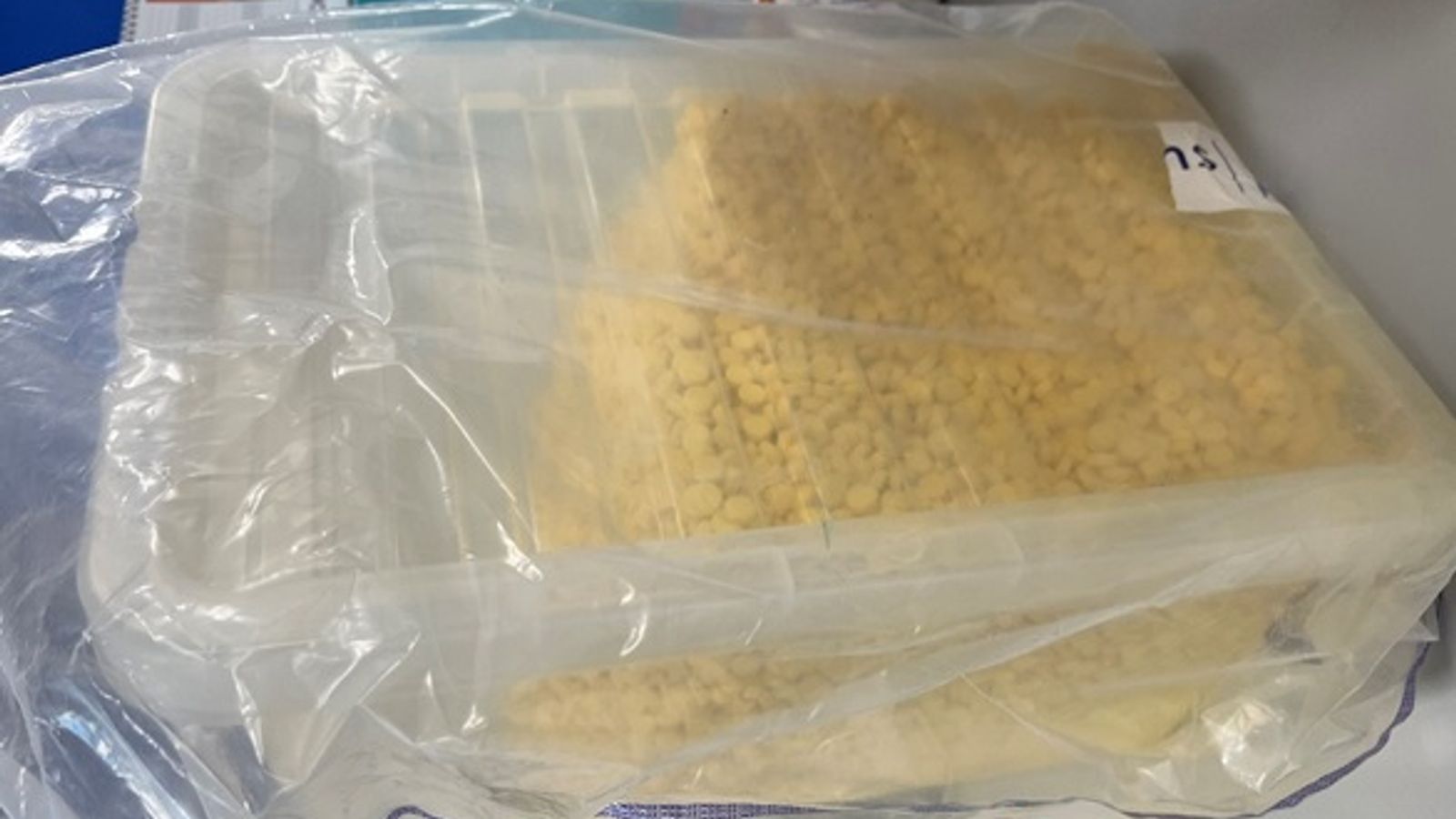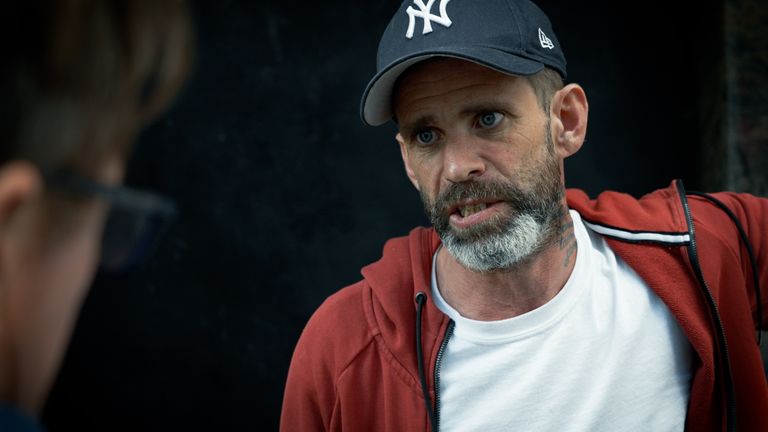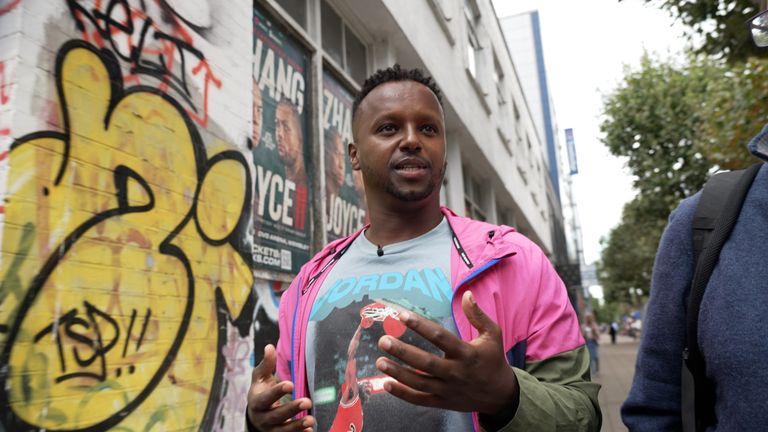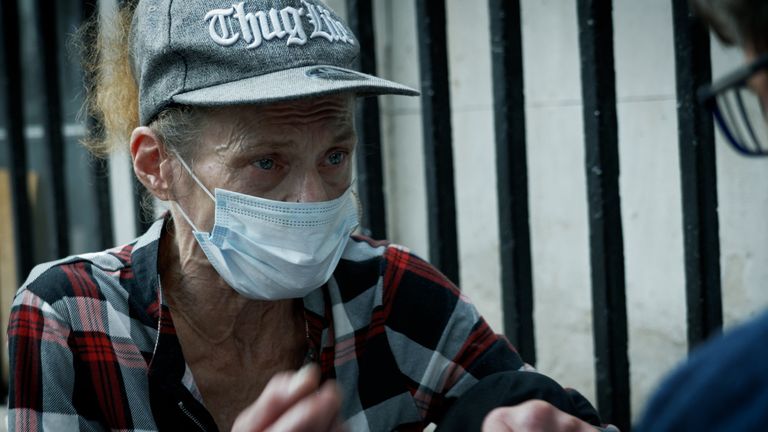Charlotte, not her real name, wanders back and forth with her empty coffee cup held out towards the tide of commuters coming through the barriers.
Rush hour at Whitechapel underground station is the best time of day for the small, frail, 23-year-old to earn enough change to pay for her next hit.
She’s agitated, but for the briefest moment agrees to talk. I ask if any symptoms from her drug use have changed recently. “I’ve got holes in my legs,” she says. “There’s no skin, just holes. It’s painful.”
Her legs are bandaged. She says the strange bores in her flesh have only appeared in the last few months and is unsure why.
But drug charity workers are convinced this is a symptom of a terrifying evolution in the drug market – a growing prevalence of dangerous synthetic opioids being cut into drugs like heroin.
The deadliest, nitazenes, are the newest killer on the streets.
“I’m seeing people coughing up blood. I’m seeing people dying,” says crack cocaine user Rory, who we meet in Aldgate in East London.
“Any drug you are buying off the street you’re taking a risk. These people are in it for the money and the purer it is, the less they make – so they are putting other stuff in it.”
The opioid fentanyl is 50 times stronger than heroin and is the primary drug in North America, where synthetic opioids are estimated to have caused 75,000 deaths in the US last year.
Nitazenes have similar properties to fentanyl, but can be up to 300 times stronger than heroin. Only this week, several have been classified as Class A drugs.
First detected in the UK from a sample of white powder found in the back of a taxi in Wakefield in April 2021, nitazenes have since been found in heroin, cannabis, cocaine, in a vape and most prevalently in black market pills sold as the anti-anxiety drug diazepam.
‘Substantial risk of overdose, hospitalisation, and death’
In October, a police raid on a “sophisticated factory” in Waltham Forest recovered approximately 150,000 nitazene tablets, the largest-ever recovered stash of synthetic opioids. Eleven people were arrested.
Detective Superintendent Helen Rance, who is leading the investigation, said: “Synthetic opioids have been detected in batches of heroin found in London and across the UK; they substantially raise the risk of incredibly serious harm to the user and are believed to be linked to a number of deaths.”
Recently, the opioid is thought to have been cut into a batch of drugs in Dublin, causing 57 people to overdose within a few days.
Professor Eamon Keenan, from the Health Safety Executive, said: “These pose a substantial risk of overdose, hospitalisation, and death.”
Meg Jones, director of social justice charity Cranstoun, said: “We are seeing nitazenes pop up in pockets all over the UK and it is incredibly concerning.”
She added: “There are an increasing number of synthetic opioids being detected in drugs that people thought were very different. We need to see government action quickly on this, because we are sleepwalking into what I would deem to be a public health crisis, and we are not prepared for it in the UK at all.”
Action means more testing and provision of drugs that can counter the effects of opioid overdose.
Read more:
The killer painkiller
Opioid that’s 500 times stronger than morphine faces tougher controls after 25 deaths
Taliban crackdown means drugs produced in UK are more deadly
Outreach worker Abdirahim Hassan, founder of East London community group Coffee Afrik, agrees. He showed me a video of a young woman who appears to have overdosed. She is slumped unconscious on the pavement in Whitechapel.
Her body is in the prayer position, her torso flat over her knees, her face pressed against the ground. “She’s just frozen. Her eyes are closed, and people are just walking past,” said Abdirahim. “She’s a young woman, maybe 24, somebody’s daughter.”
Abdirahim said a crackdown on heroin production by the Taliban has successfully stemmed the flow of heroin from Afghanistan which had previously provided 95% of the UK heroin market. That’s led to a boom in the easier to produce, more deadly synthetics.
“What it means is there’s a much higher risk of overdose and death,” he said. “But it’s a cheaper product and more potent so people are in greater crisis and there is not enough testing.”
Birmingham also saw a spike in the detection of nitazenes. Sky News was given access to a unique project in West Midlands police cells, run by the charity Cranstoun.
Steve Whitby is a drug and alcohol worker who visits suspects in their cells. The idea is that drug rehabilitation services reach out to offer support to addicts while they are in police custody.
On one cell visit, Steve warns an addict, who is also a suspected shoplifter, about the dangers of nitazenes. He told him: “So these are synthetic drugs that dealers are putting into heroin – but it’s causing lots of people to die from overdose.”
He told the man he shouldn’t take drugs alone and that he will leave a kit with his belongings which includes two syringes of naloxone, an antidote of opioid overdose. He explained the man will have to teach whoever is with him how to use it.
This pilot in Birmingham is believed to be the first time naloxone has been given to addicts in custody, and the charity said this needs to become a national provision.
The Cranstoun programme in police custody suites is funded by the West Midlands police and crime commissioner.
“In essence, this saves more lives than any other intervention,” said Steve as he demonstrated how to inject the clear liquid into the side of the thigh.
He said sometimes it’s dispensed to the children of addicts so they can save their parents lives if they overdose.
As such a newcomer to the UK market and often concealed as something else, there is little data about the prevalence of nitazenes.
The opioid is even more dangerous for those who have never taken it before
However, Wedinos, a service based in Wales where people can send in their drugs anonymously, to get them tested for what they contain, has started to increasingly detect it in other illicit drugs.
They only found nitazenes five times in 2021, but have discovered it 57 times so far this year. It was in what users thought was cannabis in Manchester and cannabis vape liquid in Portsmouth.
They’ve been found most often in what users thought were the black market versions of the anti-anxiety drug diazepam, and pain medication oxycodone, 21 times each.
They are even more dangerous to people who don’t already use opioids, and therefore have no tolerance.
The reported side effects include hallucinations, irregular heartbeat, chest pains, nosebleeds, vomiting, memory loss, aggression, and overdose.
Back on the streets of Whitechapel, another heroin addict, called Rebel, sits waiting for her methadone script outside a drug rehabilitation centre.
She said heroin has changed. She hates the synthetics, describing them as a waste of money and said they don’t work, but she agrees that not knowing what she’s using makes life more dangerous. Health workers have run urine tests and warned her of other substances cut into her drugs.
“They text me and tell me something is cut in it – it’s really bad.” Rebel becomes emotional talking about the impact of her addiction. “I’m 60 now. I don’t want to die a junkie,” she said.
This week, 15 new synthetic opioids were categorised as Class A drugs by the government, but that doesn’t make them any easier for drug users to detect.
A dangerous market has become more deadly. Users like Rebel are rolling the dice every day.







